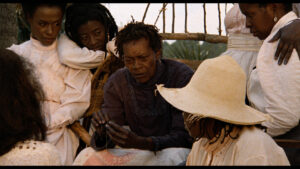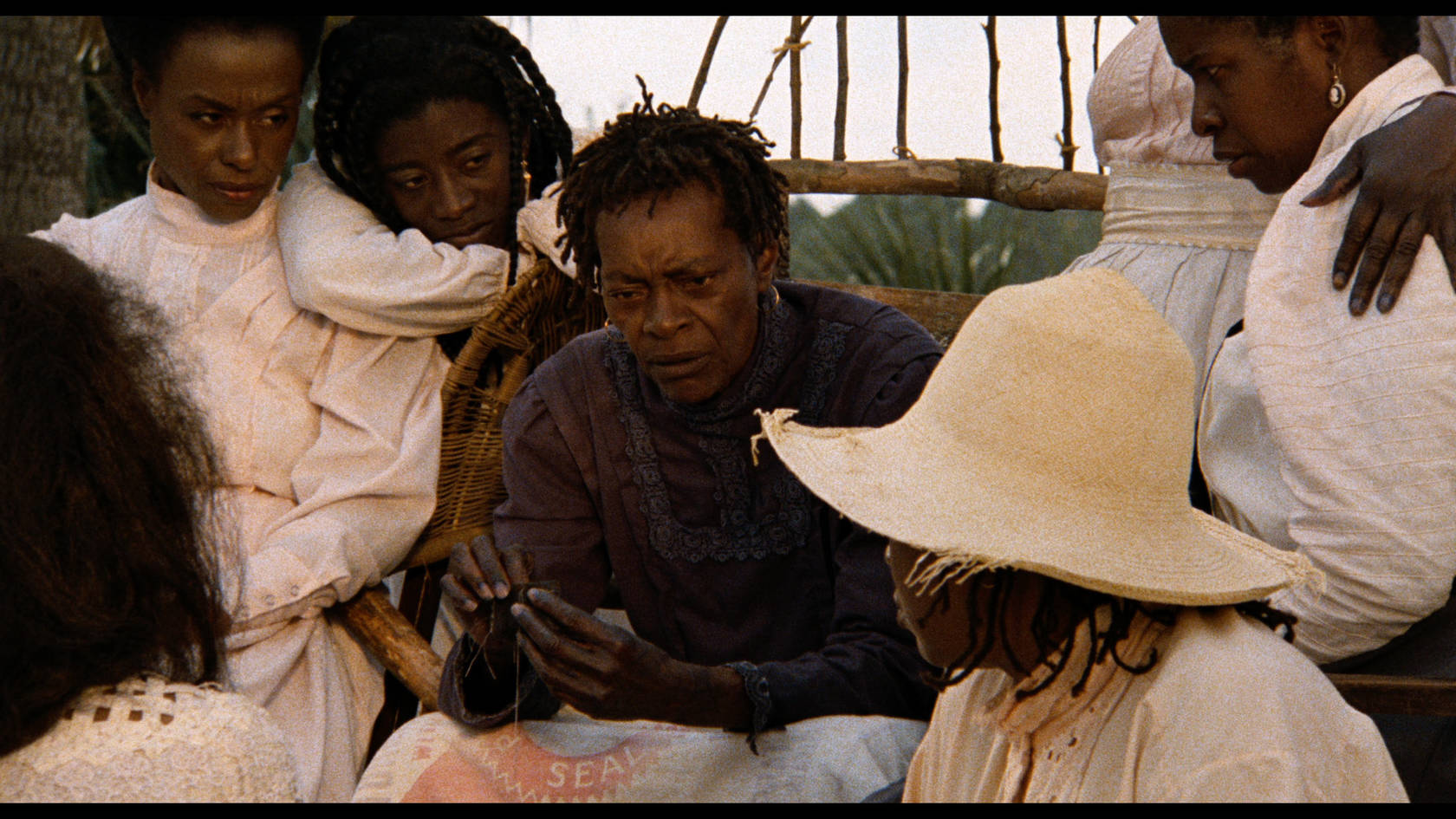Movie Info
Movie Info
- Director
- Julie Dash
- Run Time
- 1 hour and 53 minutes
- Rating
- TV-PG
VP Content Ratings
- Violence
- 1/10
- Language
- 1/10
- Sex & Nudity
- 1/10
- Star Rating
Relevant Quotes
Remember that you were a slave in the land of Egypt, and the Lord your God redeemed you; for this reason I lay this command upon you today.

Writer/director Julia Dash’s 1991 film Daughters of the Dust seems to improve for me with each new viewing. Set in 1902 at an important family picnic at Igbo Landing on Dataw Island (St. Helena Island), the story centers on three generations of Gullah women of the Peazant family as most of the family prepare to migrate to the North in search of a better way of life. It is inspired by the director’s father’s Gullah family background who inhabited the Sea Islands of Georgia. Its members joined the African-American diaspora that began near the beginning of the 20th century. Along with its excellent quality, the film is distinguished in that it was the first feature by an African-American woman to be shown in theaters throughout the United States.
There is a touch of mysticism to the proceedings, beginning with the narrator who is called “The Unborn Child” (Kai-Lynn Warren). At present she resides in the womb of Eula (Alva Rogers), whose husband Eli (Adisa Anderson) is suspicious that the father of the child is the white man who raped her. This is increased by her refusal to tell him who it was that had raped her—she knows all to well what happens to a Black man who futilely attempts to bring a white rapist to justice.
Eula is the granddaughter of the 88-year-old family matriarch Nana (Cora Lee Day). Nana, who does not intend to leave the island, is akin to the griot of their African ancestors. A mystic, she keeps alive the family stories and memories and customs of their ancestors, keeping some mementoes in the large round tin she keeps by her side. She declares, “I am the first and the last. I am the honored one and the scorned one. I am the whore and the holy one. I am the wife and the virgin. I am the barren one and many are my daughters. I am the silence that you can not understand. I am the utterance of my name.”
ecause the ancestors were enslaved for work on the island’s large plantations while their owners, due to the humid climate and diseases, lived on the mainland, the slaves were able to retain more of their African customs and beliefs than mainland slaves. We see the girls, clad in long snow-white dresses, playing African games on the beach, and everyone speaking Gullah, a patois of English and African words and phrases. Nana leads in ancient rituals, and some of the men even retain their Muslim faith, one of them Bilal Muhammad, reading in one scene from an Arabic book which we take to be the Quran.
Two women cousins are returning to the island as the film begins. The prodigal Yellow Mary (Barbara-O) had fled the island and wound up with her white employers in Cuba, where, after leaving them, she had found prostitution the only way she could survive. Apparently it paid her well, as she is now decked out in finery and has brought along her “girlfriend” Trula (Trula Hoosier). The two plan to start a new life in Nova Scotia, but have stopped over for the last family gathering at the homestead The other women regard her as “ruint,” and thus scorn her. The second returning woman, Viola Peazant (Chryl Lynn Bruce), also is the granddaughter of Nana. She had left for Philadelphia some time ago and become a zealous Christian. She especially disparages Yellow Mary. We will not be able to mistake her as the film progresses, because she is the only woman who wears a black skirt and a jacket rather than white.
To make a record of the final family gathering Viola has brought along the professional Black photographer Mr. Snead (Tommy Hicks). Attired in a suit and straw boater, he carries his large tri-podded camera everywhere. With his flashgun held height in his left hand, he will take many portraits of individuals and small groups, eventually corralling all of the large gathering to set up a group photo. He also serves as our representative, with some of the characters filling him in on the details of their family and of Gullah culture.
Another woman Haagar (Kaycee Moore) has married into the family but belittles its African heritage, calling Nana’s rituals “hoodoo.” She has been the spark, igniting the younger Peazants’ desire to seek a more prosperous life in the North. Her daughter Iona (Bahni Turpin) is in love with St. Julian Lastchild. (Bahni Turpin), a Native American who will not leave the island. Early in the film the young Cherokee writes her a love letter asking that she stay behind and marry him, which she reads to a couple of her cousins. She seems undecided as to what she should do.
Although the story does move toward the family’s mass departure, the film is nonlinear, the camera jumping around among individuals and small groups as new details about the characters are revealed. For white viewers, the film is an immersive experience, with very sketchy information being given about what is going on, such as the intriguing circle games played by the children and line dances by the adolescent girls,. Thus, we appreciate when Eula and Eli relate to Mr. Snead a few details of the myths and legends of the island. The myth concerns the slaves who supposedly either flew or walked on the water back to Africa. At this point of telling, Eli wades into the water to rescue an African carving of a female, possibly a symbol of those brave slaves. The legend, based on fact, is of the Ibo slaves who walked into the water where their heavy iron chains dragged them under surface to drown. Contrary to the myth told by Eula, Bilal later declares, to Mr. Snead, “No man come up out of that water.”
All answer the call when the food is ready. The shrimp gumbo, fresh clams, yellow corn and johnnycake constitute a rich feast equal to any served in a gourmet restaurant. And, as the partakers talk, we continue to learn more about this remarkable family. Yellow Mary shares with Eula an anecdote from her time in the city. She was drawn to a lovely pink silk music box in a shop window, for which she had no spare money to buy. Nor, asserting her independence, was she about to ask a man to buy it for her. So, she kept it in her memory and decided to lock away in it everything that “bad people” said about her, thus preventing any of it from defining her. One more example of how strong these Gullah women are! Eula, in turn, will draw close to Yellow Mary and urge the family to accept and welcome the prodigal back into the family.
Nana continues to urge the family not to migrate from the island, crying out, “How can you leave this soil? This soil? The sweat of our love is in this soil.” She performs an ancestral ritual which convinces Eli that though Eula was raped by a white man, he, Eli, is indeed the father of the daughter within his wife’s womb. Nana also takes a Bible and wraps around it a strand used in her rituals, thus combining the ancient with the new. ”Respect your elders, respect your family, respect your ancestors,” she says. The conclusion of the film honors both the past and the present of the community, as well as offering hope—hope for those who do leave the following morning, and for those staying behind with Nana—a couple of the latter might surprise you. (More on this in the question section.)
The print that is available for free on YouTube must be a copy of the newly restored film made for its 25th anniversary for screening at the 2016 Toronto Film Festival and a theatrical rerelease—it is far crisper and brighter than the usual YouTube film, and thus far, free of pesky ads. Writer/director Julia Dash educates us concerning a little known portion of Black history and culture. Nana is an admirable, inspiring example of a strong leader keeping alive memories of the past that can sustain the present and inspire the future. Very similar to those in the Hebrew Scriptures who continually admonished the people to “Remember this!” Beautifully photographed by Arthur Jafa, the lovely images of the white-gowned women will linger in your memory for a long time to come. Maybe even encourage you to join Ancestry!
This review is in the Sept.2023 issue of VP along with a set of questions for reflection and/or discussion. If you have found reviews on this site helpful, please consider purchasing a subscription or individual issue in The Store.

